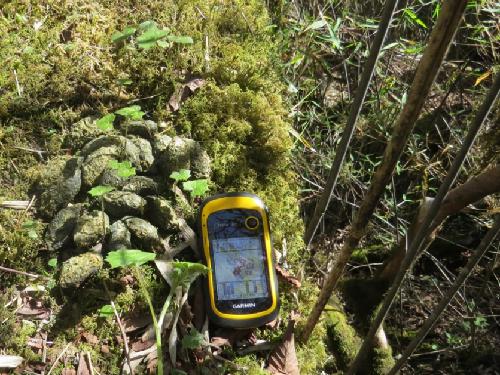Ganesh Ghimire
1. To determine the distribution and population status of A. fulgens in Lamjung district.
2. To distinguish current threats to A. fulgens and its habitat.
3. To raise awareness of A. fulgens and the ecological importance of the species’ bamboo forest habitat amongst local people by means of conservation awareness programs.

Team leader, Ganesh Ghimire, surveying Red panda habitat in Mugu district (2016) during the national Red panda survey. © Dhan Bhadur Rokaya.
Origin of project: In 2016, I worked as a field biologist in western Nepal during the national Red panda survey conducted by the Red Panda Network (RPN) in collaboration with the government of Nepal. I found that the species had not been reported from Lamjung district despite the survey results revealing the presence of suitable habitat in the district and claims by the people from Ghermu VDC that they had seen Red pandas in nearby forest.

Forest Guardians were trained in the use of GPS to record the co-ordinates of localities where evidence of Red panda activity, such as fresh droppings.
The Red panda (Ailurus fulgens) is classified as Endangered by IUCN and is protected under Nepal’s National Parks and Wildlife Conservation Act, 1997. Information on the status of the Red panda has always been limited in Nepal and there are still many areas that have not been surveyed, leaving our knowledge of the distribution of this species incomplete. Publications have shown that very little is known about its ecology, food behavior and bamboo selection in western Nepal and there exists, therefore, a compelling need for further research.
The Specific contributions of this project will be to determine the distribution and population status of A. fulgens in Lamjung district, distinguish current threats to the species, and, by means of community conservation programs, to raise awareness amongst local people of the Red panda and the ecological importance of the bamboo forests in Lamjung district for Red panda conservation. Moreover, this project also aims to involve communities directly in the conservation of the species and the protections of its habitat.
Line transects, evidence gathering (pellet collection, foraging marks, footprints and scratch marks), questionnaires, herbarium collections, social surveys, conservation awareness programs, and training for forest guardians will be carried out to determine the presence of A. fulgens in Lamjung and to assess the status of, and threats to, its habitat.
It is hoped that the new research data collected will result at least in the publication of one scientific paper. This will form a permanent record of research and will serve to broadcast the survey’s results to an international scientific audience and to raise the profile of the Red panda throughout the immediate region.
All information accumulated during the project will be presented in a final report, which will be disseminated to the Department of National Parks and Wildlife Conservation; the National Trust for Nature Conservation; Annapurna Conservation Area headquarters in Pokhara; the Central Department of Zoology, Tribhuvan University, Kathmandu; I.U.C.N. Nepal, and the Red Panda Network.